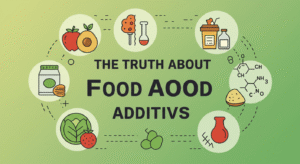Food additives
I’m excited to talk to you today about a topic that touches all of us, even if we don’t always think about it—food additives. If you’ve ever glanced at the ingredient list on a packaged food product, you’ve probably noticed some strange-sounding words like “citric acid,” “propylparaben,” or “sodium benzoate.” You may have even wondered, What exactly are these things? Are they safe? Should I be worried about what’s in my food?
We live in an age where food is more accessible, convenient, and abundant than ever before. But this convenience often comes with a catch. In order to extend shelf life, preserve flavor, improve texture, or give foods that perfect look, manufacturers often add all kinds of ingredients to our food—many of which we don’t even recognize. Some of these additives are perfectly harmless, while others may raise concerns when it comes to our long-term health.
Now, I know that when we hear the term “food additives,” it can sound a little alarming. We might picture chemicals or mystery substances being dumped into our food. But the reality is that food additives are not all bad, and many have been used safely for years to improve food safety, quality, and even nutritional content. On the other hand, there are additives that may not be as harmless as they seem, and knowing which ones to watch out for can make a real difference in the choices you make for yourself and your family.
We’re going to dig into the truth about food additives: what they are, why they’re used, which ones are beneficial, and which ones you might want to avoid. I’m going to help you understand the good, the bad, and the hidden additives that can be lurking in your food without you even knowing it. By the end of this, you’ll have the tools you need to make more informed decisions about what goes on your plate.
What Are Food Additives?

Food additives are substances added to food to preserve its shelf life, enhance its flavor, improve its texture, or make it look more appealing. They can be natural or synthetic, and they’ve been used in food for centuries. Think about salt as a preservative in meat or sugar in jams. These are natural examples of additives, and they’ve been around forever.
But in the modern food industry, the list of food additives is much longer—and much more complex. Some of these additives are used to do things like make foods last longer on grocery store shelves (think: processed snacks that stay fresh for weeks), or to make foods more visually appealing (hello, bright orange cheese powder). They can also improve texture, help with the manufacturing process, or even boost nutritional content.
The Good: Food Additives That Are Safe and Beneficial
Now, not all food additives are bad. In fact, many are totally safe and can be quite beneficial. Some of them actually help keep our food safer and more nutritious.
For example:
- Vitamins and minerals: Certain food additives are added to fortify food, like folic acid in bread or cereals to help prevent birth defects, or vitamin D in milk to support bone health.
- Preservatives: Preservatives like vitamin C (ascorbic acid) or citric acid help keep food from spoiling too quickly. These are particularly useful in preventing the growth of harmful bacteria in products like fruit juices, canned foods, and processed meats.
- Coloring agents: Ever wondered how canned tomatoes look so bright and red? Some natural food coloring, like beet juice powder or turmeric, is used to make food look more appetizing without posing any harm.
These types of additives are approved by food safety organizations, including the FDA in the U.S. or the European Food Safety Authority (EFSA) in Europe. They’re rigorously tested for safety before they can be used in foods. So, while they may sound strange, most food additives you see are safe in the amounts we consume them.
The Bad: Additives You Might Want to Avoid

That said, not all food additives are created equal. Some additives have been linked to potential health risks, especially when consumed in large quantities over time.
Here are a few food additives that have raised concerns:
- Artificial sweeteners (like aspartame, sucralose, and acesulfame potassium): While they help cut calories and sugar, there’s ongoing debate over whether they have long-term effects on metabolism, gut health, or even cancer risk. Some studies suggest they could mess with your body’s ability to regulate blood sugar or increase cravings for sweeter foods.
- Artificial food colorings (like Red 40, Yellow 5, or Blue 1): These synthetic dyes are commonly used to give candy, sodas, and processed snacks that bright, vibrant color. But there’s some evidence suggesting they might cause hyperactivity or allergic reactions, especially in children. In fact, some countries have already banned or restricted certain artificial dyes.
- BHA and BHT (butylated hydroxyanisole and butylated hydroxytoluene): These are antioxidants used to prevent fats in foods from going rancid. However, both have been classified as potential carcinogens by some research studies. They’re often found in things like snack foods, cereals, and oils.
- Sodium nitrate and sodium nitrite: These preservatives are often used in processed meats like bacon, hot dogs, and sausages to give them that signature pink color. However, when heated, these compounds can form nitrosamines, which have been linked to an increased risk of certain cancers.
Now, before you panic and throw away everything in your pantry, it’s important to note that the risk with food additives is usually related to long-term exposure or eating them in excessive amounts. Moderation is key. But being aware of these additives—and choosing alternatives when possible—can help reduce your overall intake.
The “Hidden” Food Additives: What You Should Look Out For
Some food additives may be harder to spot on labels, especially if they have unfamiliar names or are used in small quantities. If you’re concerned about additives, it’s helpful to keep an eye out for these common culprits:
- Monosodium glutamate (MSG): Used to enhance the savory flavor in foods like processed meats, soups, and snacks, MSG has been a subject of controversy for years. While it’s considered safe by the FDA, some people report experiencing headaches or flushing when they consume foods containing MSG.
- Partially hydrogenated oils: These are a source of trans fats, which have been linked to heart disease and other health issues. Look for phrases like “contains trans fats” or “partially hydrogenated” on labels, and try to limit your intake of these fats.
- High-fructose corn syrup (HFCS): Found in many sweetened processed foods, HFCS has been associated with weight gain, insulin resistance, and an increased risk of type 2 diabetes. While the occasional soda or processed snack isn’t likely to ruin your health, reducing your intake of HFCS is a good idea for long-term well-being.
How to Make Smarter Choices
So, what does this all mean for you as a consumer? Here are some quick tips for navigating the world of food additives and making smarter choices:
- Read the Labels: Yes, I know—food labels are a little daunting sometimes. But taking a quick look at the ingredient list can tell you a lot about what’s actually in the food you’re buying. Focus on products with fewer, simpler ingredients, and avoid anything that looks like it was made in a lab.
- Choose Whole Foods: The more you can stick to whole, minimally processed foods (fruits, vegetables, whole grains, fresh meats, etc.), the fewer additives you’ll have to worry about. Whole foods often have little to no added preservatives or artificial ingredients.
- Look for Organic or Natural Alternatives: If you’re concerned about synthetic additives, try choosing organic products. Organic foods are generally free from synthetic food colorings, preservatives, and artificial sweeteners. They may also have fewer additives overall.
- Moderation Is Key: It’s not about cutting out all processed foods or completely avoiding additives—that would be pretty hard to do. But moderation is the key. By balancing your diet with whole foods and occasional indulgences, you can minimize the risks associated with excessive food additives.
- Stay Informed: Research is always evolving, and what’s considered safe today may change in the future. Staying informed about the latest findings on food additives can help you make better choices for your health.
Not all food additives are bad. Many additives, like preservatives, colorings, and fortifying agents, are put into food for practical reasons, and many of them are completely safe in the amounts we typically consume. In fact, they help ensure the safety, quality, and longevity of the foods we buy. They allow us to enjoy foods that are convenient, nutritious, and—let’s face it—delicious.
But at the same time, there are some additives that, if consumed too frequently or in large quantities, might pose health risks. For example, artificial sweeteners, artificial food colorings, and certain preservatives have been linked to concerns ranging from allergies and sensitivities to potential long-term effects on metabolism and even cancer risk. While regulatory agencies like the FDA deem these additives safe in the amounts we’re exposed to, it’s still smart to be aware of what’s in your food and how much you’re consuming.

And lastly, remember this:
The food industry is constantly evolving, and the safety of food additives is something that’s continually being studied and regulated. Just because a product contains an additive doesn’t necessarily mean it’s unsafe. But being an informed consumer means you’re equipped to make better choices for yourself and your family. Trust your instincts, stay curious, and keep an eye out for any new information that might help you navigate this complex world of food.
I hope this topic has given you a better understanding of food additives and how to make more informed choices about what goes into your body. If you’re still unsure about certain additives or want to dive deeper into the subject, don’t hesitate to reach out or do more research—it’s all about being proactive with your health.
Thanks so much for reading, and remember: The more you know, the better decisions you can make when it comes to what you eat. Stay mindful, stay curious, and take charge of your food choices. Your body will thank you!
For more articles in Nutrition, click here
Visit Our Authority Sources
- FDA – Food Additives Overview
- NIH – Research on Food Additives
- EFSA – Food Additives Safety in Europe







